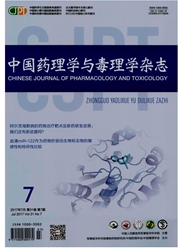

 中文摘要:
中文摘要:
目的研究N-甲基-D-天冬氨酸(NMDA)受体非竞争性拮抗剂地佐环平(MK-801)对短暂电击所致创伤后应激障碍(PTSD)模型小鼠行为学的影响,探讨NMDA受体拮抗剂在PTSD治疗中应用的可能性。方法 1 ICR小鼠ip给予MK-801 0.0125,0.025,0.05和0.1 mg·kg-1,5和10 d后进行自发活动测试,观察小鼠自发活动。2连续2 d给予ICR小鼠不可逃避的足底电击(每天15次,0.8 m A,间隔10 s,持续10 s)制备PTSD模型。第1天电击后5 min,ip给予MK-801 0.0125,0.025和0.05 mg·kg-1或ig给予盐酸舍曲林15 mg·kg-1,每天1次,连续16 d。其中第3,8和15天测定僵住时间;第9天进行自发活动实验,观察水平跨越次数和垂直站立次数;第13天进行高架十字迷宫实验,观察进入开臂的次数和在开臂的滞留时间;第16天进行爬梯实验,观察爬梯数和站立次数。结果 1 MK-801 0.1 mg·kg-1连续给药5或10 d可显著抑制小鼠自发活动(P〈0.01),其他各给药组对小鼠自发活动无显著影响。2与正常对照组比较,电击组、MK-801各剂量组及舍曲林给药组小鼠的水平跨越格数和垂直站立次数均无显著性差异;与正常对照组小鼠相比,电击组小鼠的僵住时间显著增加(P〈0.01);小鼠进入开臂的次数和在开臂滞留时间的百分比显著减少(P〈0.01);爬梯实验中小鼠的站立次数显著增加(P〈0.01),提示模型建立成功。电击后小鼠的PTSD样行为学变化可以被伴随给予舍曲林15 mg·kg-1逆转,但MK-801无法逆转电击后小鼠的PTSD样行为。结论在不影响小鼠自发活动的剂量范围内,MK-801在小鼠短暂电击模型上无抗PTSD的行为学效应,单纯拮抗NMDA受体未必能发挥抗PTSD作用,这可能与PTSD发病机制的复杂性和NMDA受体结构与功能的复杂性有关。
 英文摘要:
英文摘要:
OBJECTIVE To investigate the effect of dizocilpine(MK-801 ), a N-methyI-D-aspartate (NMDA) receptor antagonist, on alleviating the enhanced anxiety and fear response in a mouse model of post-traumatic stress disorder (PTSD) induced by inescapable electric foot shocks. METHODS MK-801 (0.0125, 0.025, 0.05 and 0.1 mg·kg-1, ip) was given to ICR mice for 10 d. On the 5 th day(d 5) and dl0, the locomotor activity was measured. Fifteen Intermittent inescapable foot-shocks (intensity= 0.8 mA, interval= 10 s, and duration. 10 s) were delivered to each mouse for 2 d. From d 1 after the foot-shock procedure, sertraline (15 mg·kg-1, ig) or MK-801 (0.0125, 0.025 and 0.05 mg·kg-1, ip) was given once a day for 16 d. Each mouse was successively tested for contextual freezing measure- ment (d 3, d 8 and d 15), locomotor activity test (d 9), elevated plus maze test (d 13) and staircase test paradigm (d 16). RESULTS ~ Mice repeatedly treated with MK-801 (0.1 mg·kg-1) for 5 or 10 d significantly decreased the locomotor activity( P〈0.01 ), but no significant changes in other groups were observed. Electric foot-shocks or drug treatment (sertraline or MK-801 ) caused no significant differ- ence in the number of line crossings and rearings between these groups. Compared with normal control group, the freezing time was significantly increased( P〈0.01 ), the percentage of time spent in and num- ber of entry into open arms of the shocked mice were decreased( P〈0.01 ), and the number of rearings in the staircase test of the shocked mice was significantly increased( P〈0.01 ), indicating that an electric foot- shocks model was successfully established. All these behaviors were reversed by sertraline (15 mg·kg-1), but not by MK-801. CONCLUSION MK-801, at a dose of that does not affect the locomotor activity in mice, exerts no anti-PTSD therapeutic effect in the inescapable electric foot-shock induced mouse model of PTSD. MK-801, which antagonizes NMDA re
 同期刊论文项目
同期刊论文项目
 同项目期刊论文
同项目期刊论文
 Repeated exposure to chlorpyrifos alters the performance of adolescent male rats in animal models of
Repeated exposure to chlorpyrifos alters the performance of adolescent male rats in animal models of 期刊信息
期刊信息
